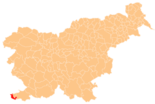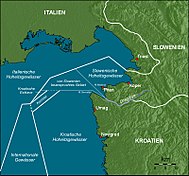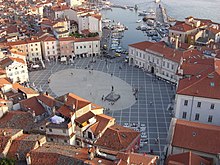Piran
|
Piran Pirano |
|||
|
|||
| Basic data | |||
|---|---|---|---|
| Country |
|
||
| Historic region | Coastal land / Primorska | ||
| Statistical region | Obalno-kraška (coast and karst) | ||
| Coordinates | 45 ° 32 ' N , 13 ° 34' E | ||
| surface | 44.6 km² | ||
| Residents | 17,782 (January 1, 2017) | ||
| Population density | 399 inhabitants per km² | ||
| Post Code | 6330 | ||
| License Plate | KP | ||
| Structure and administration (as of 2010) | |||
| Mayor : | Peter Bossman (Socialni Demokratie) | ||
| Mailing address | Tartinijev trg / Piazza Tartini 2 6330 Piran / Pirano |
||
| Website | |||
Piran ( Italian Pirano , German obsolete: Pirian ) is a city in the extreme southwest of Slovenia on the coast of the Adriatic Sea . With its location, old town and Venetian architecture, the city on the Slovenian Riviera is one of the most famous tourist centers in the country.
name of the city
The city name probably comes from the Greek word pyros for fire. According to legend, instead of a lighthouse on the headland Punta, where the place was built, a fire showed the ships the way to the Greek colony of Aegida (Koper). Piranum is first mentioned in writing in the 7th century.
history
In the years 177/178 BC The Istrian peninsula was conquered by the Romans. During this time the gradual colonization and romanization of the area began. This resulted in scattered settlements in the area of today's Piran. The urban development of Piran began in the 7th century under Byzantine rule with a fortified settlement. In 788 Istria was occupied by the Franks and politically incorporated into the Friuli region . After the division of the Franconian Empire, the county of Istria was incorporated into the Italian Kingdom in 843 and incorporated into the Holy Roman Empire in 952 and then incorporated into the Duchy of Bavaria .
In the second half of the 13th century Venice began conquering Istrian cities and in 1283 also occupied Piran. In 1692 the violinist and composer Giuseppe Tartini was born in Piran . Tartini Square was named in his honor in 1894.
From 1809 to 1813 Piran was briefly part of Napoleon's Illyrian Province . After that it became Austrian again . Imperial Austria had inherited the Republic of Venice here and brought Piran a new period of prosperity in the 19th century. The salt pans in particular contributed to this, as Austria increased the Sečovlje salt pans to an annual production of 40,000 tons with the revival of salt production .
After the First World War , with the Treaty of Rapallo in 1920 , Istria fell to war victor Italy, which had occupied Istria since November 1918. A strict policy of Italianization followed and the Slovene language was banned from the public.
During the Second World War , Italy, which no longer wanted to fight with Germany, had to submit to the German Reich in 1943 ; this also applied to Istria. After the war, the region around Trieste was again disputed between Italy and Yugoslavia . The area was therefore divided into two zones under UN administration . Piran belonged to the southern zone B , which included the western part from Istria to Mirna. It was not until the London Agreement of 1954 that the Free Territory of Trieste was dissolved and Zone B officially annexed to Yugoslavia .
Today Piran lies in the border area with Croatia. Despite the EU arbitration award of June 29, 2017, the exact course of the border, especially in the Bay of Piran, is still controversial between the two countries.
population
The community has around 17,000 inhabitants on an area of 45 km². The city itself has 4,100 inhabitants.
At the 2002 census, 78.6% of the population were Slovenian citizens, 10.0% Croatians, 5.4% Bosnians , 2.8% Yugoslavs , 1.9% EU citizens (then EU-15), 0.8% Macedonians and 0.6% others.
The majority of the population (66.7%) stated Slovene as their mother tongue in this census . The most important minority languages are Croatian (8.4%) and Italian (7.0%). According to their own information, 3.0% spoke Serbo-Croatian , 2.1% Serbian , 2.0% Bosnian and 3.7% other languages.
The official languages of the municipality of Piran are Slovenian and Italian. Public signage, schools, kindergartens and the University of Primorska are basically bilingual.
geography
location

The municipality borders on Croatia in the south and the municipalities of Koper and Izola in the east . It also has a maritime border with Italian territorial waters in the north. The highest point is the 289 m high Baretovec pri Padni . The city has the Portorož regional airport and a marina .
Community structure
The municipality comprises eleven localities. Due to the fact that both Slovenian and Italian are the official languages of the municipality, there are designations for these names in both languages. Population figures (as of January 1, 2017):
|
|
Postal outline
The municipality of Piran includes the following postal areas (population figures from the 2002 census):
- postal 6330 Piran (ital. 6330 Pirano ):
- Piran (Italian Pirano ), 4142 inhabitants, 15 m. i. J.
- postal 6320 Portorož (ital. 6320 Portorose ):
- Portorož (Italian: Portorose ), 2849 inhabitants, 2 m. i. J.
- Lucija (Italian Lucia ), 5,792 inhabitants, 25 m. i. J.
- Seča (Italian Sezza ), 942 inhabitants, 25 m. i. J.
- Strunjan (Italian Strugnano ), 564 inhabitants, 2 m. i. J.
- postal 6333 Sečovlje (ital. 6333 Sicciole ):
- Sečovlje (Italian Sicciole ), 584 inhabitants, 20 m. i. J.
- Parecag, 910 inhabitants, 35 m. i. J.
- Sv. Peter, 329 inhabitants, 210 m. i. J.
- Dragonja (ital. Dragogna ), 296 inhabitants, 20 m. i. J.
- Nova vas nad Dragonjo, 193 inhabitants, 268 m. i. J.
- Padna , 156 inhabitants, 215 m. i. J.
Piran Bay
The bay of Piran , named after the city, is important as a shipping route for the Slovenian port of Koper .
Neighboring communities
| Gulf of Trieste | Izola | Twill |
| Gulf of Piran |

|
|
| Buje ( HR ) |
climate
The predominant Mediterranean climate is characterized by mild average temperatures (January: 4.4 degrees, July 21.5 degrees). Three typical winds can be found in this part of the Adriatic: from the northwest the moderate mistral ( Maestral ), the stronger, hot south wind Scirocco ( Jugo ) from the southeast from the Sahara and the stormy, gusty , cold bora downwind from the northeast with wind speeds of up to to 200 km / h, which lasts up to two weeks in winter and often only a few hours to a day in summer.
Attractions
- At the western tip of the headland is the castle-like church of Sv. Klementa (St. Clementa), which is considered the symbol of the city.
- About 100 meters east of Tartini Square is a Franciscan monastery , which is used for concerts in summer and in the basement of which you can see a collection of paintings by Venetian painters.
- On the northern cliff of the peninsula, the Cathedral of Sv. Jurij (St. George) the city that was built in 1637. The steeple of the cathedral is modeled on the Venetian tower of St. Mark . The top of the church tower is adorned with a sword-bearing statue of the city patron Saint George. The figure rotates according to the direction of the wind and thus serves as a weather vane for the citizens of the city .
Old town
The old town with its narrow streets extends on an approximately one kilometer long, pointed headland in an east-west direction. On the land side, it is delimited by a partially preserved historical defensive system with battlements and towers.
In the city center in the Italian-Venetian style there are some architectural monuments and viewpoints. The southern beach promenade, from the small harbor to the tip of the headland, is lined with numerous restaurants for the tourist public.
The city festival takes place on October 15th .
Tartini Square
The center of urban life is the restored Tartinijev trg ( Italian : Piazza Tartini , German: Tartiniplatz ). It was created in 1894 when the harbor, which was then located at this point, had become too small and was used as a garbage dump, was finally filled in. In the center of the square is a larger than life bronze statue of the eponymous composer Giuseppe Tartini , created by the Venetian artist Antonio Dal Zotto , which was unveiled on August 2, 1896 on the occasion of his 200th birthday.
A redesign of the square was commissioned for the composer's 300th birthday. The white stone ellipse laid by the architect Boris Podrecca is reminiscent of the turning point of the electric tram (1912–1953) as well as of the fishing port that shaped urban life in this place in the past.
The ensemble of the square includes the classical town hall on the north side and a Gothic patrician house to the right. The Benečanka (Venetian House) was built by a wealthy Venetian merchant for his lover who lived in Piran. The corner of the house shows the face of the loved one. The facade facing Tartini Square contains a relief with the Italian inscription lassa pur dir ("Let them talk").
Museums
At the port of the old town there are three museums on the theme of the sea to be visited. The aquarium at Kidriĉevo nabrežje 4 shows the marine fauna of the Adriatic. The Pomorski muzej (Sea Museum) in Cankarjevo nabrežje 3 presents the economic use of the sea (fishing, Slovenian seafaring, salt production). The Muzej pod vodnihdejavnosti (Underwater Museum ) in Župančičeva 24 deals thematically with diving and shows, for example, shipwrecks .
leisure
- In the north of the peninsula, an approximately one kilometer long coastal footpath ("shore promenade") with interesting rock layers on the steep walls of Piran leads to the lake and beach of Fiesa.
- The Sečovlje Saltworks Nature Park is located in the area of the municipality directly on the Croatian border . The northernmost still managed salt pans in the Mediterranean are located near the district of Strunjan .
Culture and economy
School system
In addition to Slovenian and Italian kindergartens, there are four Slovenian and Italian primary schools each in Piran , in which around 1,700 children are educated. There are also four secondary schools: the Piran grammar school, the Antonio Sema grammar school with Italian language lessons, the Portorose Middle School for Maritime Studies and the Middle School for Health Care. There are also universities for seafaring and transport, hotels and tourism as well as for business and entrepreneurship in the municipality.
Broadcasting station
The place is the location of a radio and television transmission system of the Radiotelevizija Slovenija . A 123.6 meter high steel truss mast with a trap antenna is used as the antenna carrier, as it is also used to broadcast two medium wave programs.
traffic
From 1909 to 1912 the city was the starting point for the trackless railway Pirano – Portorose , one of the first trolleybus operators in Austria-Hungary.
From 1912 to 1953, a tram licensed as a small train for the benefit of the United Gas Works of Augsburg with a gauge of 760 millimeters, which is unusual for trams , ran between Piran (Tartiniplatz) and Portorož (station Triest – Parenzo ) . The route revision of the line planned in 1911 took place at the beginning of January 1912, on July 20, 1912 the line was opened to traffic.
sons and daughters of the town
- Giuseppe Tartini (1692–1770), Italian violinist and composer
- Cesare Dell'Acqua (1821–1905), Italian painter
- Domingo Brescia (1866–1939), Italian composer and music teacher
- Alenka Dovžan (* 1976), Slovenian ski racer
Patron saint
The patron saint of the city of Piran is Saint George . This can be found again in the blue framed red George Cross of the city coat of arms. Furthermore, there is a representation of the dragon slayer with a sword on the top of the steeple of the town church St. Georg.
Panoramas
See also
- International conflicts in the successor states of Yugoslavia
- Sečovlje salt pans
- List of territorial disputes
literature
- Hermann Prechtl: Istria's west coast. A trip from Trieste to Pola. In: Foreign newspaper. Central organ for the promotion of foreign and travel traffic in and to Austria and the adjacent Bavarian highlands , No. 19/1900 (XIII. Year), February 17, 1900, pp. 1–3. (Online at ANNO ). .
- Dieter Schulze: Slovenia. Experience the highlights of the country directly, discover nice places and immerse yourself in everyday life, the most beautiful excursions into nature. With a large folding plan . (First edition). DuMont-Reiseverlag, Ostfildern 2012, ISBN 978-3-7701-9631-9 , pp. 66–69.
- Christian Lehner: Piran for all seasons. With trips to Portorož, Koper, Izola and the Strunjan and Sečovlje nature parks. In: Kulturwanderungen. Verlag Johannes Heyn, Klagenfurt 2015.
Web links
- Piran Municipality website at piran.si.
- Pictures of Piran on mypics.at.
Individual evidence
- ^ Georg C. Heilingsetzer: Piran in Advent: Time to stroll through town. on diepresse.com from December 21, 2017.
- ↑ Piran on the Slovenian Adriatic on portoroz.biz.
- ↑ History of Piran (no longer accessible in 2018).
- ↑ Piran on schindler-bs.net.
- ↑ 3.7% other languages = 0.8% Albanian , 0.4% Macedonian , 0.2% German , 0.1% Hungarian , 2.2% other. The remaining 7.1% did not provide any information. Source: www.stat.si. 2002, accessed August 7, 2013 .
- ↑ Population tables of the Statistical Office of the Republic of Slovenia ( Slovene )
- ↑ Piran: Municipality, Local Tourist Organization 1999, p. 6.
- ↑ Theater and Art. (...) A Tartini monument (...). In: Wiener Abendpost. Supplement to Wiener Zeitung , No. 171/1896, July 27, 1896, p. 3, top right. (Online at ANNO ). .
- ↑ Christian Lehner, p. 56f.
- ↑ Piran: Municipality, Local Tourist Organization 1999, pp. 10-11.
- ↑ Elektroservisi: Popravilo sidrnih vrvi na antenskem stebru OC Beli Križ ( Memento of the original dated August 6, 2011 in the Internet Archive ) Info: The archive link was inserted automatically and has not yet been checked. Please check the original and archive link according to the instructions and then remove this notice. (no longer available online).
- ↑ RGBl 1912/132: promulgation of the Ministry of Railways, on the licensing of a electric motor to be operated schmalspurigen Klein web of Pirano to Portorose. In: Reichsgesetzblatt for the kingdoms and states represented in the Reichsrathe , year 1912, p. 621 ff. (Online at ANNO ). .
- ↑ Strassenbahn Magazin 2/2013, p. 72.
- ↑ Projected systems. (...) Portorose. In: Electrical engineering and mechanical engineering. Journal of the Electrotechnical Association in Vienna. Organ of the Association of Austrian and Hungarian Electricity Companies / Electrical Engineering and Mechanical Engineering. Journal of the Electrotechnical Association in Vienna (and organ of the branch association Brno) / E. u. M. (E and M) electrical engineering and mechanical engineering. Journal of the Electrotechnical Association in Vienna / E and M electrical engineering and mechanical engineering. Journal of the Electrotechnical Association in Vienna from 1883 to 1938 / E and M electrical engineering and mechanical engineering. Organ / magazine of the Electrotechnical Association of Austria , year 1912, appendix Industrial and Economic News , No. 4/1912 (XXX. Year), p. 53 center. (Online at ANNO ). .
- ↑ Projected systems. (...) Pirano. In: Electrical engineering and mechanical engineering. Journal of the Electrotechnical Association in Vienna. Organ of the Association of Austrian and Hungarian Electricity Companies / Electrical Engineering and Mechanical Engineering. Journal of the Electrotechnical Association in Vienna (and organ of the branch association Brno) / E. u. M. (E and M) electrical engineering and mechanical engineering. Journal of the Electrotechnical Association in Vienna / E and M electrical engineering and mechanical engineering. Journal of the Electrotechnical Association in Vienna from 1883 to 1938 / E and M electrical engineering and mechanical engineering. Organ / magazine of the Electrotechnical Association of Austria , year 1912, appendix Industrial and Economic News , No. 30/1912 (XXX. Year), p. 421, top left. (Online at ANNO ). .













